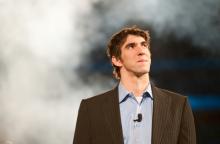Culture

Meet the social media “nones.” A new survey finds that Americans, while mostly religious, generally do not use social media to supplement worship and mostly keep their faith private online.
The Public Religion Research Institute survey found about one in 20 Americans followed a religious leader on Twitter or Facebook. A similar number belonged to a religious or spiritual Facebook group.
The results seem to defy the familiar story of prominent religious leaders using social media to build a following – and a brand.
“We were surprised when this turned up really low levels of people engaging religion and faith online,” said PRRI research director Daniel Cox.

Michael Phelps was accomplishing things no one in recorded history has ever done before. I can’t explain or really comprehend how he can do it. And although he did them, I attribute his physiology and gifts to God. So is what he does in the Olympics a miracle?
It almost seems that we worship him as if they were miraculous acts. We literally put him up on a pedestal and adore him, much like how people adored Jesus. And just like with Jesus, these amazing feats, whether or not they are literally miraculous acts, are simply not enough. The fall will inevitably come.
If they were, Jesus wouldn’t have been abandoned at his most vulnerable moment. Some will argue that he saved the biggest and best for last, raising from the dead, which finally put all of his doubters in their place. Really? Then why are our numbers, at least in the Western World, in such precipitous decline?

God bless our media!
Inside the blog, see how Team Coco managed to get dozens of broadcast news anchors to say the same thing ... over, and over, and over again.
"We've gotta get an envelope!" ~ Andy Richter

Back in the 1970s, when I still was living near William F. Buckley in Switzerland close to my parent’s ministry, L’Abri Fellowship, from time to time the author would visit my mother and father for tea.
My late father (the theologian Francis Schaeffer) and Buckley had little in common apart from a shared love of art, the Swiss Alps, and a sense that the West was in a decline that only Christianity could reverse — even if they would not have agreed on what that word “Christianity” meant. WFB was a bon vivant Roman Catholic and Dad was a “biblical inerrancy” fundamentalist.
Dad would serve tea, but I could tell that, as the afternoons wore on, Buckley might have preferred an offer of something a bit “stiffer,” as the Brits call a real drink. Later, in the early '80s, Buckley and I were comparing notes about speaking (I’d just addressed the Southern Baptist convention before I fled the evangelical scene), and he mentioned that he agreed with Winston Churchill who said, "You can't make a speech on ice water."
Dad was a teetotaling Presbyterian. Notwithstanding, Buckley — perhaps to annoy my father — once said, rather pointedly, that he always demanded a couple of glasses of wine before taking to the podium.
When I learned of Gore Vidal’s passing Wednesday, I recalled Buckley talking to Dad and me about how Vidal and he used to go hammer-and-tongs arguing on TV — mostly on Buckley’s program Firing Line — only to go have a drink together after the show.
A 14-year-old kid meets John Lennon and interviews him in I Met the Walrus --- creative ways to re-purpose labyrinths and skeeball machines --- P is for Pixar --- indie rock music's Trade Deadline Day. See these and more in today's Links of Awesomeness...

A Westboro Baptist Church protest was overshadowed last Friday when demonstrators dressed as zombies gathered at a DuPont, Wash. military base to counter the radical group's efforts.
After members of the controversial Kansas-based church announced plans to picket Joint Base Lewis-McChord, a military base south of Seattle, 27-year-old Melissa Neace decided to organize a counter-protest, launching a Facebook group titled "Zombie'ing Westboro Baptist Church AWAY from Fort Lewis!"
"We wanted to turn something negative around, into something people could laugh at and poke fun at," Neace told the News Tribune. "It was the easiest way to divert attention from something so hateful."
About 300 counter-protesters showed up in varying degrees of zombie garb, far outnumbering the picketers from Westboro. According to KIRO in Seattle, just eight protesters from the controversial group showed up.
"I think that their message is very hateful, and Jesus was not a hateful person. He loved everybody," one of the counter-protesters told KIRO.
Watch video of Zombies vs Haters inside the blog ...
Aiming to Shine
The debut album by Korean-American hip hop artist Gowe (pronounced “go,” it stands for Gifted On West East), We are HyperGiants, feature lyrics that touch on race, culture, and materialism, while unabashedly praising Jesus. www.facebook.com/TeamGowe
Can I Get a Vision?
If you’re blessed with vacation time this summer, don’t forget to let yourself dream. In Dreaming, Memphis Theological Seminary professor Barbara A. Holmes explores the power of dreams as a place for refueling our personal and social imaginations and meeting the mysterious, living God. Fortress Press

IF YOU’VE EVEN casually watched TV in the past five years, seen a movie with coming attractions, driven past billboards and fast food restaurants, or walked into a Barnes & Noble, you can’t avoid the onslaught of vampires in popular culture. As the summer draws to a close, so does the fourth season of HBO’s vampire comedy-drama True Blood. This summer’s vampire big screen attractions—the movie remake of the 1960s vampire soap opera Dark Shadows and the movie adaptation of the young adult novel Abraham Lincoln: Vampire Hunter (it is, improbably, exactly what it sounds like)—have come and gone. The fourth season of CW network’s young adult vampire melodrama The Vampire Diaries begins in September. And the publicity blitz for the final Twilight movie, Breaking Dawn-Part 2, (coming to theaters in mid-November) is about to colonize fast-food merchandise, billboards, and magazine covers.
Ever since John Polidori wrote “The Vampyre” as part of a bet with his good friend Mary Shelley and since Bram Stoker gave us Dracula, the vampire has never exactly gone out of fashion. Vampires are often the horizon on which we project our fears and anxieties, and, like other supernatural fantasy creatures, they help us take stock of our own humanness. If, as Nina Auerbach has argued in her book Our Vampires, Ourselves, we can learn a lot about different epochs of Western culture by the kind of vampires that are in vogue, what do we make of this current crop of blood suckers? What might they teach us about our humanity and our theological response to the world we live in?
If you sink your teeth into these contemporary vampire mythologies, the first thing that is likely to strike you is how attractive these vampires are. In the three vampire mythologies most popular right now, the Twilight series (originally young adult novels, now also movies), The Vampire Diaries (also originally YA fiction from the early 1990s, revived as a TV show in 2009), and True Blood (HBO’s most-watched series, based on adult supernatural romance novels), it is often hard to imagine a good reason why one wouldn’t want to be a vampire oneself. They are super-fast, super-strong, super-sensory beings, who also happen to be astonishingly attractive. And let’s not forget how many amazing skills one could learn—much less all the books one could read, languages one could speak, art one could appreciate—if one lived forever.

THOSE OF US who are passionate about prison reform could talk at length about the injustices of the penal system, but prison activists and concerned citizens sometimes gloss over the internal conflicts of prisoners in their daily lives as well as the pain and fears of crime victims in local communities. The documentary Concrete, Steel, and Paint raises some essential questions about hope, forgiveness, and reconciliation through the moving story of unlikely partners—those incarcerated for committing violent crimes and those affected by violent crimes—who come together to create a mural in their community.
The film begins at Graterford Prison near Philadelphia, a maximum-security institution where men are serving long sentences for violent crimes, including homicide. The men interviewed for the film seem thirsty for opportunities for healing. One of the first prisoners we meet, Tom, says: “When you do wrong that you can’t correct, it’s horrible.” Another inmate, Zafir, tells the camera: “I don’t want my legacy to be that I was a murderer.”
The energy for a mural project came from Jane Golden, the executive director of the Philadelphia Mural Arts Program, who believes in the power of art, and murals in particular, “to shift the consciousness of a community.” Golden began working with prisoners in Graterford in the early 2000s. The men in her workshops eventually came up with the idea to reach out to the community. “I thought it was an interesting idea,” Golden says, “but I told them the only way this can possibly work is if we can get the community involved.”
After a significant amount of pushback from community members, Golden suggests making two separate mural walls to convey the different journeys of offenders and victims. “It’s healing for me to tell my story,” says the mother of a homicide victim. “Maybe it will be helpful for them to tell their story.” The film teaches viewers that there are points of similarity in these stories—hurt, loss, anger, regret—and there is a shared desire for healing and for change, but the journeys are still different and portraying them in shared space could minimize the ability to convey truth for each group. Can offenders and victims of crime ever share a platform to express pain, to ask for healing?

On Proverbs 8
My saints won’t be named by a church.
Their sainthood won’t stand as statues. Listen.
Voices
calm as cooking directions
play continually—
If any thing’s resurrectible, it’s memory:
those eyes,
song-haloed, so full of lightness
nothing could stop their flight;
not a Thomas who peers into pupils’ darkness,
not a ravenous soul left grounded.
We are born, yin-yanged, of lightning
with saints and putti the lightest of all.
But love-rumpled faces, quick limbs, and pierced hearts
are unstable, done only in clay.

IF YOU EVER wondered what you would get if you crossed Woody Guthrie with Jimi Hendrix, you might want to check out guitarist and activist Tom Morello, also known as The Nightwatchman, whose work combines very modern flurries of feedback and distortion with old-school Popular Front politics. Last year, Morello played a prominent role in the occupation of the Wisconsin state capitol in support of public employees’ unions, and this May Day he led a “guitarmy” through the streets of New York, singing “This Land Was Made for You and Me” in support of Occupy Wall Street.
Morello first made his name playing with Rage Against the Machine, a 1990s band that blended a potent Molotov cocktail of rock, rap, and revolution. For most rock stars, getting political means promoting Amnesty International or Greenpeace, but Rage’s favorite organization was the Mexican revolutionary Zapatista Army. After Rage fell apart, the guitarist had another successful band, Audioslave, fronted by former Soundgarden singer Chris Cornell. Audioslave was a great rock band, but it lacked a political agenda. Morello is a great rock guitarist, but one with a political science degree from Harvard who said he finished his degree because he wanted to “learn how to get my hand on the levers and be an effective revolutionary.” So simply making cool noises couldn’t possibly keep him satisfied for long. Soon Morello was turning up for open mic nights at folkie clubs, disguised as his alter ego, The Nightwatchman.
The Nightwatchman’s singing made it pretty clear why Morello had always worked behind a front man. He often sounds like an unfortunate cross between Woody Guthrie and Lou Reed. But The Nightwatchman found his niche in political contexts, such as Madison and Wall Street, where the point was to get the people singing. This new role on the street has also given a new direction to Morello’s music. Last fall he released a Nightwatchman album, World Wide Rebel Songs, that included a full rock band and found Morello beginning to integrate the Hendrix and Woody sides of his musical personality.
CHUCK COLLINS’ new book does exactly what an introduction to wealth inequality and all its faults needs to do: summarize without oversimplifying, and provoke dialogue and action about the urgent problem of what Collins memorably dubs the U.S.’s “inequality death spiral.”
Newcomers to the topic will find a concise overview of how wealth inequality has skyrocketed since 1980, how a small elite has changed the rules to enable still higher inequality, the many seen and unseen ways that’s a problem for us all, and the beginnings of a solution. Those more familiar with the subject can benefit from Collins’ overview, well-selected statistics, and well-honed, direct turns of phrase. Those who want deeper reading will find excellent footnotes at the end of the slim volume. Everyone will find her experience livened by the stark words Collins quotes from people identifying as part of the 99 percent—and those who are part of the 1 percent.
Collins’ many years as an advocate against inequality show in the book’s graceful balance: It emphasizes the usefulness of the 99 percent-vs.-1 percent idea, while also making clear that neither side is monolithic. He acknowledges very real economic, class, and racial divisions among the 99, but makes a compelling case against letting those differences be the basis of divide-and-conquer political strategies: “It is important that the 99 percent see that they have some important common ground, rather than be peeled into a hundred subgroupings.” And Collins, who himself grew up in the 1 percent, refuses to demonize it or to accept the demoralizing falsehood that it is unified against those below. Rather, he quotes multiple allies within the economic elite, while decrying how “a small segment of the 1 percent—with an organized base in Wall Street’s financial institutions—has worked over many decades to rig the rules of the economy” in the areas of “taxation, global trade, regulation, and public spending.”
AFRICAN-AMERICAN women’s wisdom emerges from an experience of triple (or more) oppression. Denied the dignity of womanhood, condemned for their skin color, whether too dark or too light, and often imprisoned by mis-education, demeaning and meaningless work, and a denial of their very humanity, African-American women have yet managed to forge a spirituality of hope and survival that has sustained them for centuries.
As Alice Walker noted, they dreamed dreams and had visions; they imagined a time and place when the pain and indignity of their lives would be transcended, not in some far-off heaven but right here in the future of their children and their children’s children. Somehow our foremothers persisted in their faith. They made rosaries out of beads and knotted string and learned scripture by rote memory. They resisted as best they could anything and anyone who attempted to keep them from living their faith on a daily basis.
Once freedom, so-called, came, they struggled, despite the callous disregard of their fellow Christians, to remain faithful. When their children were forbidden entry into diocesan or public schools, when they were required to sit in upper galleries and back pews, when they had to wait until last to partake of the sacraments, they did not suffer these indignities quietly but often walked out and with their meager resources built their own schools and church buildings.

IN THE 1930s, the Marx Brothers took political satire seriously enough to make a comedy about imperialism. Duck Soup stands today as one of the most comforting movie antidotes to the depressing post-9/11, enemy-until-proven-friend political culture. The 1960s saw Stanley Kubrick upgrade the cinematic presentation of war into Dr. Strangelove: Or How I Learned to Stop Worrying and Love the Bomb—employing the Screwtapian dictum that if the devil cannot bear to be mocked, then the best way to reveal the horror of war is to laugh at it. A decade later, Mel Brooks attacked—and transcended—white supremacy in Blazing Saddles, a film whose coruscating offensiveness is merely a mirror to our own prejudices. Sacha Baron Cohen is the evident successor to the Marxes, Kubrick the comic satirist, and Brooks. (Some of Michael Moore’s work, and both Armando Iannucci’s In the Loop and Chris Morris’ Four Lions, deserve attention in this light too.)
Baron Cohen’s trilogy of fish-out-of-water-in-the-U.S.A. films, Borat, Bruno, and current release The Dictator, taken together, constitute both deliriously funny entertainment (sometimes confused, and with something to offend truly everyone) and a jeremiad against the monstrosities of our time: racism, sexual violence, homophobia, xenophobia—and that’s just for starters. The Dictator has post-9/11 politics, the war on terror, Islamophobia, and anti-Semitism clearly in its sights. Our hero—for that is what he ultimately becomes—is a Middle Eastern tyrant in the Saddam/Gadhafi mold, with a bit of Ahmadinejad and even Kim Jong-Il thrown in for good measure. He gets lost in New York and experiences what life is like outside the palace, leaving behind its personal executioner and other amenities. His path to liberation and respecting others comes through working in a vegan grocery store—not an unrealistic program in the non-cinematic world. What’s remarkable about his transformation is that it comes in response to meeting a broader variety of characters than you’d find at the U.N., and to being mentored in treating sexuality (his own and others’) with more respect.

THE TAR SANDS in Alberta, Canada, have been in the news a lot lately, since they appear to be a promising source of energy for the United States, a nation hungry for a fuel derived by despoiling pristine forests, fouling fresh water sources, and enriching oil executives. (Nobody said capitalism would be pretty. Cute and cuddly, perhaps, but not pretty.)
Actually, I’m not familiar with this new type of energy source. Is it the tar we want, or the sand? Probably not the tar, since it’s too sticky and is mainly used as a preservative for saber-toothed tiger skeletons in California, something I learned in an eighth grade history book with lots of pictures. (I like pictures.)
So it must be the sand, which one day our cars will run on, to which I must add: Are our scientists brilliant, or what?!
Unfortunately, extracting this energy source domestically could be a direct threat to our beaches, the nation’s principal source of sand. Which is why I plan to Occupy the Beach of My Choosing later this summer, and stand in powerful protest—or, after a heavy picnic lunch, lie on a blanket in powerful protest—against exploiting this valuable resource.
Come to think of it, Saudi Arabia has lots of sand. So maybe we can get it from them.
A monkey finds hidden camera at the zoo, photographs self --- big slumber party hits IKEA --- Peter jackson confirms The Hobbit will be three films --- and check out some of the funniest faces in the Olympics. See these and more in today's Links of Awesomeness...

A wealthy Dutchman builds a replica of Noah’s Ark, following the measurements outlined in the book of Genesis.
Johan Huibers, who lives in the Dutch town Dordrecht recently opened a public “Bible museum,” inside his 300-cubit wooden vessel. The massive boat, known as “Johan’s Ark,” not only includes life-size plastic animals, but also a theater, restaurant, sleeping quarters, and conference facilities large enough to seat 1,500 guests.
He tells CNN that inspiration for the project came in 1992, after the low-lying Netherlands were flooded by the North Sea. "The next day I bought a book about Noah's Ark. That night while sitting on the couch with my kids, I looked at it and said: 'It's what we're going to do,'" reports CNN.

Among my must reads are the Sunday New York Times Book Review and other book reviews I come across in various media outlets. There are too many books being published that I would love to read, but just don’t have the time. So, I rely on reading book reviews as one way of keeping in touch with what’s being written.
Here are my picks in this week’s books of interest.
Big Olympic news today from Reutuers:
China has vehemently rejected suggestions of doping as a growing row over the astonishing performance of a Chinese swimmer threatens to overshadow Michael Phelps’s bid to become the most decorated Olympian of all time on Tuesday.
For those of you who don’t speak in sports lingo or Britishisms, that translates to “Chinese coaches reject claims that their star swimmer, Ye Shiwen, has been taking illegal, performance-enhancing drugs.”
Here’s the context. Yesterday, Ye Shiwen, a 16-year-old Chinese woman swam the 400 meter medley faster than all-star swimmer Ryan Lochte, a man from the U.S.A.
WHAT??!! Throw up the red flag! Women can’t be better than men at sports! Call in the drug dogs and blood tests. (The Twitterverse and other social media quickly echoed similar sentiments, rolling their collective eyes at outrage that a woman could break a man's speed.)
According to the report, Ye Shiwen went through "extremely thorough" tests from the World Anti-Doping Agency, and the British Chairman of the Olympic Association said she’s clean.
"That's the end of the story. Ye Shiwen deserves recognition for her talent."
Arrested Development filming continues --- recap July entirely in charts --- the wonders of a felt-tipped pen --- hairchitecture. See these and more in today's Links of Awesomeness...